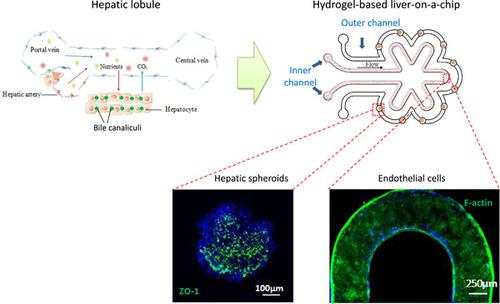当前位置:
X-MOL 学术
›
Biotechnol. Bioeng.
›
论文详情
Our official English website, www.x-mol.net, welcomes your
feedback! (Note: you will need to create a separate account there.)
Hydrogel microfluidic‐based liver‐on‐a‐chip: Mimicking the mass transfer and structural features of liver
Biotechnology and Bioengineering ( IF 3.5 ) Pub Date : 2020-10-05 , DOI: 10.1002/bit.27589 Qin Meng 1 , Ying Wang 1 , Yingjun Li 1 , Chong Shen 1
Biotechnology and Bioengineering ( IF 3.5 ) Pub Date : 2020-10-05 , DOI: 10.1002/bit.27589 Qin Meng 1 , Ying Wang 1 , Yingjun Li 1 , Chong Shen 1
Affiliation

|
Liver is fed by nutrition via diffusion across the vascular wall from blood flow. However, hepatocytes in liver models are directly exposed to the perfusion culture medium, where the shear stress reduces the cell viability and liver‐specific functions. By mimicking the mass transfer and structural features of hepatic lobule, we designed a microfluidic liver‐on‐a‐chip based on the di‐acrylated pluronic F127 hydrogel. In the hydrogel chip, hepatocellular carcinoma HepG2 and human hepatic stellate cell LX‐2 were statically cultured inside the microwells on the outer channel. These hepatic cells were fed by the diffused medium from the adjacent but separated inner channel with endothelial cell monolayers, which was perfused by the medium with physiologically relevant shear stress. As found, the hepatic cells in the liver‐on‐a‐chip rapidly formed spheroids within 1‐day incubation and expressed about one to two‐fold higher viability/liver‐specific functions than the corresponding static culture for at least 8 days. Moreover, the presence of endothelial cells also contributed to the expression of liver‐specific functions in the liver‐on‐a‐chip. Therefore, the proposed liver‐on‐a‐chip provides a new concept for construction of 3D liver models in vitro, and shows the potential value for a variety of applications including bio‐artificial livers and drug toxicity screening.
中文翻译:

基于水凝胶微流体的肝脏芯片:模拟肝脏的传质和结构特征
肝脏通过血流扩散穿过血管壁获得营养。然而,肝脏模型中的肝细胞直接暴露于灌注培养基,其中剪切应力降低了细胞活力和肝脏特异性功能。通过模仿肝小叶的传质和结构特征,我们设计了一种基于二丙烯酸化 pluronic F127 水凝胶的微流控肝脏芯片。在水凝胶芯片中,肝细胞癌HepG2和人肝星状细胞LX-2在外通道的微孔内静态培养。这些肝细胞由来自具有内皮细胞单层的相邻但分离的内部通道的扩散介质供给,该内部通道被具有生理相关剪切应力的介质灌注。据发现,片上肝脏中的肝细胞在 1 天的培养时间内迅速形成球体,并且在至少 8 天内表达的活力/肝脏特异性功能比相应的静态培养高一到两倍。此外,内皮细胞的存在也有助于肝脏芯片中肝脏特异性功能的表达。因此,所提出的肝脏芯片为体外构建 3D 肝脏模型提供了一个新概念,并显示了包括生物人工肝脏和药物毒性筛选在内的各种应用的潜在价值。内皮细胞的存在也有助于肝脏芯片中肝脏特异性功能的表达。因此,所提出的肝脏芯片为体外构建 3D 肝脏模型提供了一个新概念,并显示了包括生物人工肝脏和药物毒性筛选在内的各种应用的潜在价值。内皮细胞的存在也有助于肝脏芯片中肝脏特异性功能的表达。因此,所提出的肝脏芯片为体外构建 3D 肝脏模型提供了一个新概念,并显示了包括生物人工肝脏和药物毒性筛选在内的各种应用的潜在价值。
更新日期:2020-10-05
中文翻译:

基于水凝胶微流体的肝脏芯片:模拟肝脏的传质和结构特征
肝脏通过血流扩散穿过血管壁获得营养。然而,肝脏模型中的肝细胞直接暴露于灌注培养基,其中剪切应力降低了细胞活力和肝脏特异性功能。通过模仿肝小叶的传质和结构特征,我们设计了一种基于二丙烯酸化 pluronic F127 水凝胶的微流控肝脏芯片。在水凝胶芯片中,肝细胞癌HepG2和人肝星状细胞LX-2在外通道的微孔内静态培养。这些肝细胞由来自具有内皮细胞单层的相邻但分离的内部通道的扩散介质供给,该内部通道被具有生理相关剪切应力的介质灌注。据发现,片上肝脏中的肝细胞在 1 天的培养时间内迅速形成球体,并且在至少 8 天内表达的活力/肝脏特异性功能比相应的静态培养高一到两倍。此外,内皮细胞的存在也有助于肝脏芯片中肝脏特异性功能的表达。因此,所提出的肝脏芯片为体外构建 3D 肝脏模型提供了一个新概念,并显示了包括生物人工肝脏和药物毒性筛选在内的各种应用的潜在价值。内皮细胞的存在也有助于肝脏芯片中肝脏特异性功能的表达。因此,所提出的肝脏芯片为体外构建 3D 肝脏模型提供了一个新概念,并显示了包括生物人工肝脏和药物毒性筛选在内的各种应用的潜在价值。内皮细胞的存在也有助于肝脏芯片中肝脏特异性功能的表达。因此,所提出的肝脏芯片为体外构建 3D 肝脏模型提供了一个新概念,并显示了包括生物人工肝脏和药物毒性筛选在内的各种应用的潜在价值。











































 京公网安备 11010802027423号
京公网安备 11010802027423号